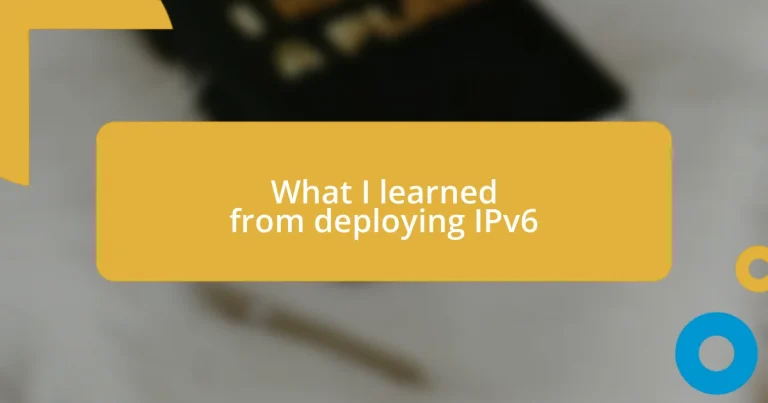Key takeaways:
- **Training and Familiarity**: A comprehensive understanding of IPv6 and its benefits is essential for stakeholders to overcome the traditional IPv4 mindset.
- **Key Benefits of IPv6**: IPv6 offers an expanded address space, improved network efficiency, and built-in security features that enhance overall network performance.
- **Collaborative Troubleshooting**: Engaging team collaboration and utilizing specialized tools during testing and troubleshooting leads to effective problem-solving and smoother migrations.
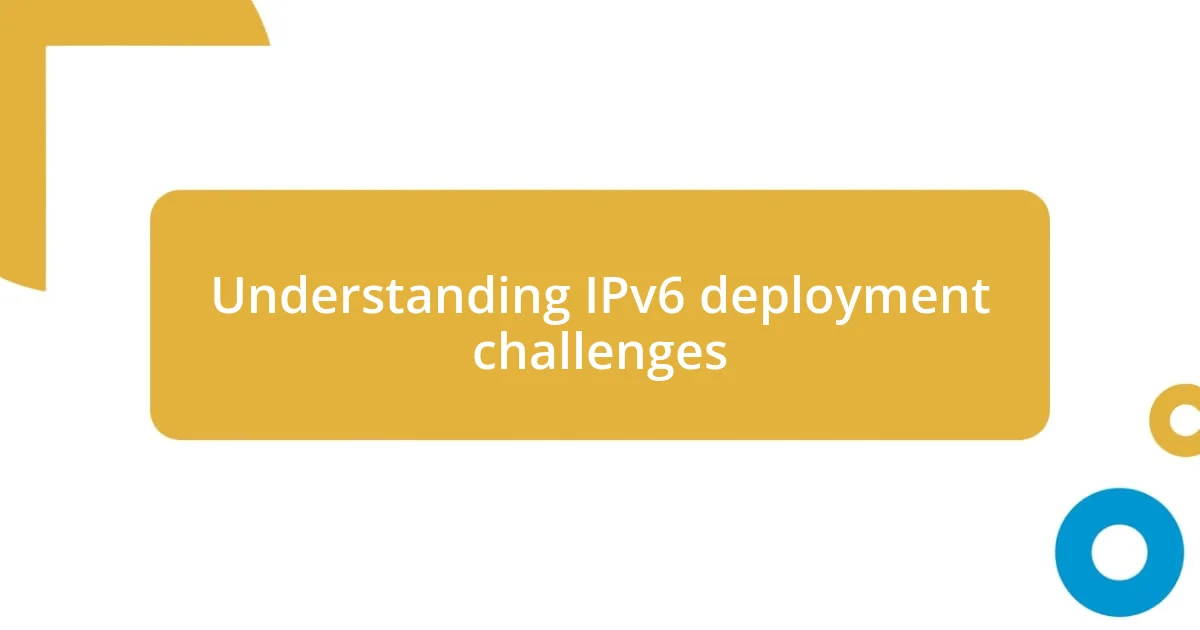
Understanding IPv6 deployment challenges
Deploying IPv6 comes with a unique set of challenges that often catch teams off guard. One hurdle I faced was the lack of familiarity among my colleagues with the new address scheme. It’s surprising how many people still cling to the IPv4 mindset, isn’t it? It made me realize the importance of comprehensive training and a strong foundation in network fundamentals before jumping into the transition.
Another significant challenge was the coexistence of IPv4 and IPv6 during the transition phase. When I set up dual-stack systems, I found myself troubleshooting network issues that arose from mismatched configurations. Have you ever felt like you were trying to juggle too many balls at once? That’s how it felt, and it underscored how critical it is to have clear guidelines in place for managing both protocols simultaneously.
Moreover, the resources needed for effective IPv6 deployment often exceed initial expectations. In my experience, the budget allocated for updates and staff training can easily be underestimated. How do you navigate that gap between enthusiasm for new technology and the realities of financial constraints? This reality check can be frustrating, but it has taught me how essential it is to plan ahead and secure buy-in from stakeholders early in the process.

Key benefits of using IPv6
Investing in IPv6 has numerous advantages. From my experience, one of the most significant benefits is the vastly expanded address space. IPv4 supports about 4.3 billion unique addresses, but IPv6 can accommodate an almost unfathomable number—340 undecillion addresses, to be exact! This means that as we continue to connect more devices to the internet, we can breathe easier knowing we won’t run out of IP addresses anytime soon. I can remember when my organization was launching new IoT devices; the thought of IPv4 exhaustion made our planning feel limited, but that concern vanished with IPv6.
Another key advantage I’ve noticed is improved network efficiency. IPv6 has a simplified packet header structure, which facilitates faster routing. With fewer processing rules required, performance can significantly improve, especially in large networks. I saw this firsthand when we switched to IPv6; our network speeds noticeably increased during high-traffic periods, minimizing latency and enhancing user experience. Have you ever tried to run smoothly on a crowded highway? Switching to IPv6 was like moving to a well-designed bypass that keeps everything flowing seamlessly.
Lastly, I want to highlight the improved security features built into IPv6 from the start. Encryption and authentication mechanisms are an integral part of its design, unlike in IPv4, where they were often an afterthought. When we faced security challenges in the past with IPv4, it felt like we were always playing catch-up. Adopting IPv6 made me feel like we were finally ahead of the curve, ensuring that our data transmissions were not only efficient but also more secure from the outset. It’s a reassuring prospect to know that the foundation of our network is fortified by modern safety protocols.
| Benefit | Description |
|---|---|
| Expanded Address Space | IPv6 offers an astronomical number of unique IP addresses, ensuring future growth and connectivity. |
| Improved Network Efficiency | Simplified header structure leads to faster routing and better performance in large networks. |
| Enhanced Security | Built-in security features like encryption and authentication provide a safer networking environment from the start. |
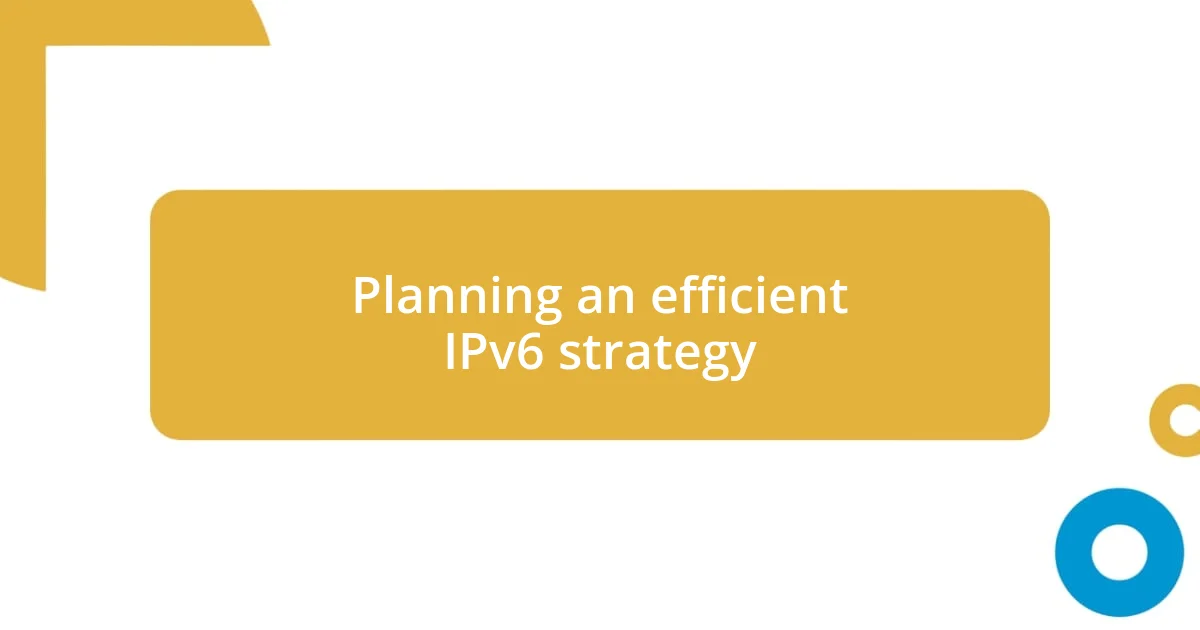
Planning an efficient IPv6 strategy
Planning an efficient IPv6 strategy requires a comprehensive understanding of your current network infrastructure. I remember vividly when we began to map out our transition, and I felt a mix of anticipation and anxiety. This planning stage is where you can truly set yourself up for success. When evaluating your existing IPv4 setup, it’s important to consider aspects like addressing schemes, device compatibility, and overall network architecture. Trust me, getting this foundation right will save you countless headaches later on.
To ensure a smooth transition, consider the following key components:
- Inventory Analysis: List all existing devices and their IPv4 configurations to identify what can support IPv6.
- Training Programs: Foster a culture of learning through workshops and hands-on training tailored to different team members.
- Pilot Testing: Implement a pilot program with a select group of users or devices before a full rollout.
- Stakeholder Engagement: Keep key stakeholders informed and involved to garner support for your plans and budget needs.
- Clear Timeline: Set achievable milestones and deadlines to keep your team focused and accountable throughout the process.
In my experience, involving all levels of the organization early in the planning can create a shared vision and minimize resistance down the line. I once encountered skepticism from a senior team member who had reservations about dedicating resources to IPv6. By addressing their concerns and showing tangible benefits through a pilot, I saw their perspective shift completely. That kind of collaboration not only makes planning more efficient but also fosters a sense of ownership across the board, transforming what could be a daunting challenge into an exciting opportunity for growth.
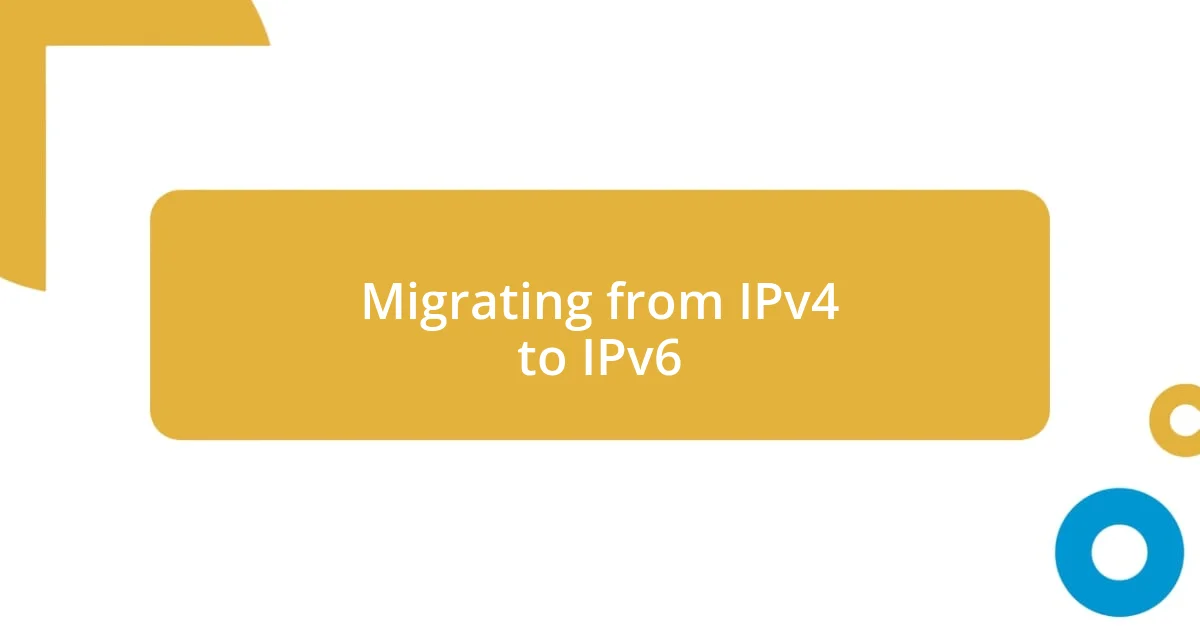
Migrating from IPv4 to IPv6
Transitioning from IPv4 to IPv6 can feel overwhelming, but I remember the moment we took that leap; it was like stepping into a new world of possibilities. This shift requires careful planning and a clear strategy. It’s essential to evaluate your current network thoroughly and identify which devices and systems can support IPv6. I still recall spending hours poring over our inventory list, discovering hidden gems that were ready for the upgrade—those moments were illuminating!
One thing I learned along the way is the importance of stakeholder buy-in. Initially, some team members were hesitant, fearing the unknown and potential disruptions. I took the time to explain the long-term benefits we’d enjoy with IPv6. It felt rewarding to transform skepticism into enthusiasm; that experience really highlighted how vital it is to communicate openly and engage everyone in the process. Have you faced similar challenges in your transitions? I’ve found that openness fosters collaboration, which leads to smoother migrations.
Lastly, piloting the transition before a full rollout is invaluable. I vividly recall our pilot group; by monitoring their experiences closely, we gained insights that shaped our final implementation. It was exciting to see the benefits of IPv6 manifest in real time. I could almost taste the success as we learned what worked and what didn’t. This approach not only mitigates risk but also helps build confidence in your team as they witness the advantages firsthand. Wouldn’t you agree that seeing tangible results makes all the difference in future endeavors?
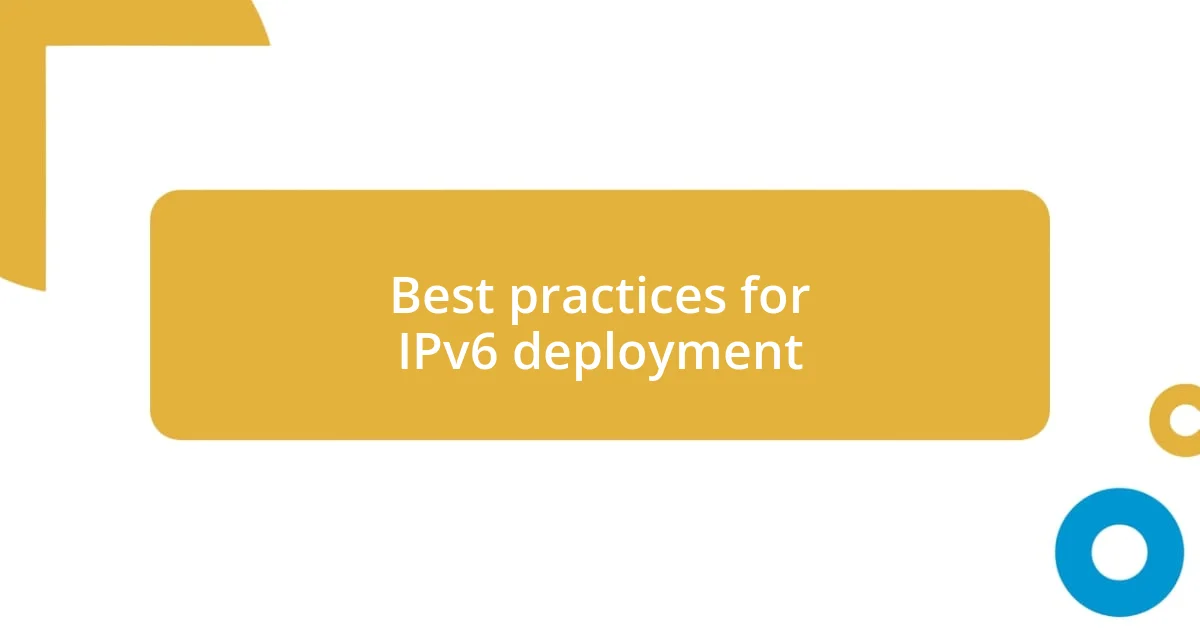
Best practices for IPv6 deployment
To ensure successful IPv6 deployment, one of the first best practices is to perform a thorough inventory of your existing network equipment. I remember when we did this; it was surprising to find legacy devices that could handle IPv6 better than expected. This diligent assessment not only helps in planning migration but also prevents costly surprises down the line. Have you ever found unexpected capabilities in your hardware? I know I certainly did, and it changed the way I viewed our transition.
Another crucial aspect is to implement robust training programs. I recall hosting a series of workshops that were met with both enthusiasm and reluctance. Seeing my colleagues’ confidence grow as they grasped the intricacies of IPv6 made all the effort worthwhile. Investing in education not only empowers your team but also bridges the gap between apprehension and mastery. How often do you think organizations underestimate the power of well-informed staff? In my experience, a knowledgeable team is a game-changer for any technological shift.
Lastly, I can’t emphasize enough the value of continuous testing and monitoring throughout the deployment process. During our transition, I closely monitored traffic patterns to understand how IPv6 was performing in real-time. It was genuinely eye-opening to adjust strategies based on actual data, allowing us to pivot and resolve issues before they escalated. How do you typically gauge the success of your tech implementations? For me, real-time monitoring became an indispensable tool, ensuring we were on the right path and maximizing our IPv6 benefits.
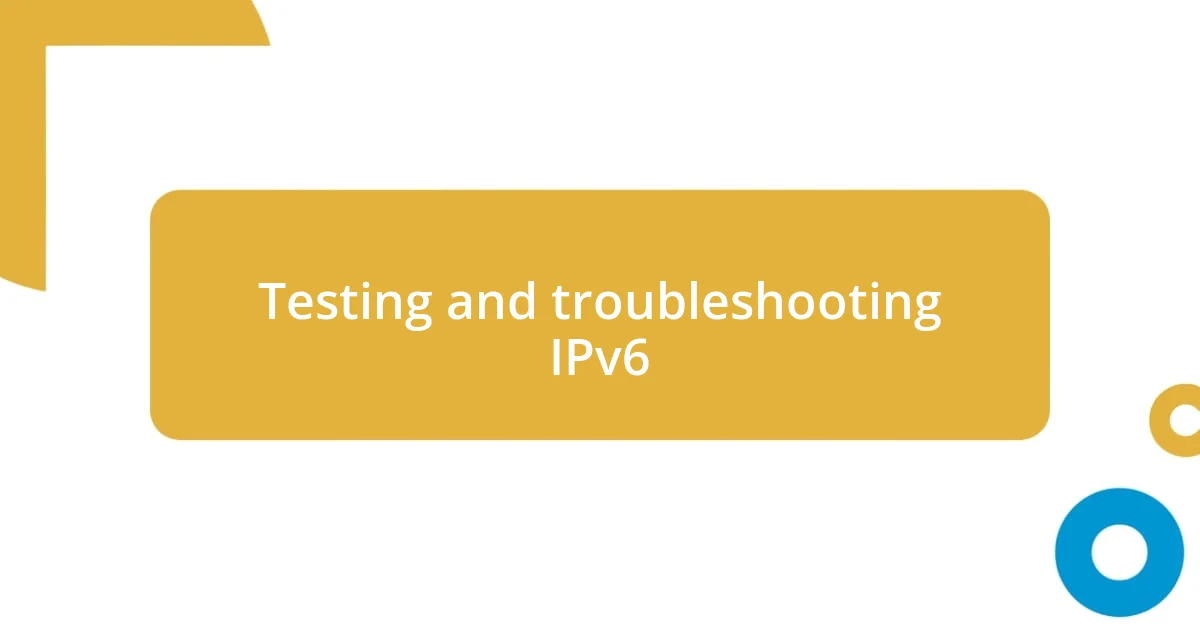
Testing and troubleshooting IPv6
Testing and troubleshooting IPv6 is a crucial phase that I’ve learned demands both vigilance and patience. I vividly remember our first round of testing, where network traffic behaved unexpectedly due to misconfigured settings. One of my team members jokingly coined it “the IPv6 maze,” and that stuck with us! It wasn’t just about finding errors; it was about exploring the intricacies of our network design and understanding the nuances of dual-stack configurations. Have you ever felt like you were uncovering a secret world within your own infrastructure? Those moments of discovery taught me the true value of thorough troubleshooting.
During troubleshooting sessions, I found that collaborative problem-solving really makes a difference. I recall one late afternoon where the power of collective brainstorming shone through. Several team members gathered around a whiteboard, sketching out potential configurations. Each idea led us further into unraveling the issues at hand, transforming frustration into a palpable sense of teamwork and achievement. It reminded me that while technical skills are vital, the human element of collaboration often lights the path forward. How often do you experience that kind of synergy in your projects?
Moreover, utilizing specialized tools to facilitate testing was a lesson in itself. I brought in an IPv6 network scanner to visualize our address space, and the way it illustrated our connectivity gaps was a real eye-opener. I could see the benefits immediately as it transformed a drain of disconnected troubleshooting into an engaging challenge. Have you ever had a tool that completely changed your perspective? I know I did; investing in the right resources turned what could have been a tedious process into a dynamic exploration of our network landscape, making troubleshooting not just necessary, but genuinely enjoyable.

Real-world case studies on IPv6
Real-world implementations of IPv6 have unveiled fascinating stories and lessons. For example, a mid-sized healthcare organization I consulted for experienced a significant surge in connectivity when they fully transitioned to IPv6. Initially, they faced skepticism internally, but once the staff saw the improved telemetry in their patient management systems, it became a shared victory. Can you imagine the relief and pride on their faces when they realized that better connectivity meant faster, more reliable access to vital patient data? It was truly a game-changer for them.
In another case, I observed a large educational institution navigating the transition. They had taken the initiative to introduce IPv6 in their campus network, which was met with a mix of excitement and anxiety among the IT staff. But they turned this into an opportunity by hosting an IPv6 challenge, inviting teams to troubleshoot real-world scenarios in a competitive format. Watching their enthusiasm build as they collaborated was inspiring. How often do you find that a touch of creativity can ignite passion in a technical environment? This event not only built skills but fostered team spirit, leaving everyone more confident in their IPv6 capabilities.
Finally, I recall a tech startup that adopted IPv6 early on, promoting it as part of their innovative identity. They faced numerous pitfalls at first, with issues arising from their aggressive deployment strategy. However, they turned those obstacles into learning moments, sharing their stories on social media and fostering a community of like-minded professionals. Seeing them transform challenges into triumphs through transparency makes me wonder—how pivotal is community support in technical transitions? Their journey laid a foundation for a supportive ecosystem where sharing knowledge became a communal experience, proving that in the world of technology, we are often stronger when we collaborate.












